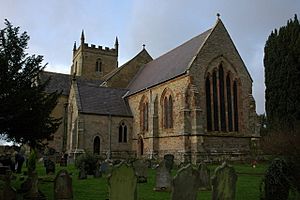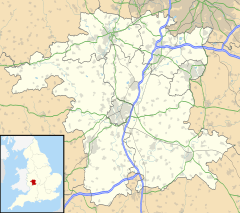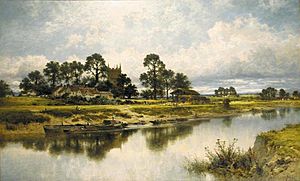Kempsey, Worcestershire facts for kids
Quick facts for kids Kempsey |
|
|---|---|
 Kempsey |
|
| Population | 2,609 (2011 Census) |
| OS grid reference | SO852490 |
| Civil parish |
|
| District |
|
| Shire county | |
| Region | |
| Country | England |
| Sovereign state | United Kingdom |
| Post town | Worcester |
| Postcode district | WR5 |
| Police | West Mercia |
| Fire | Hereford and Worcester |
| Ambulance | West Midlands |
| EU Parliament | West Midlands |
| UK Parliament |
|
Kempsey is a village and civil parish located in the Malvern Hills District of Worcestershire, England. It sits next to the River Severn on its west side. The main A38 goes through the village. Kempsey is about 3 miles (5 km) south of the city of Worcester.
This village has a very long history. Its name comes from the old Saxon words "Kemys' Eye." This means "the island of Kemys." Kemys was a Saxon chief, and his "island" was an area between marshes and the River Severn. Another road, Lyf's Lane, is named after a different Saxon chief. Kempsey was even mentioned in the 11th-century Domesday Book, a famous survey of England.
The local Anglican church, St. Mary's, was built between the 12th and 15th centuries. Its tall tower, built in the 15th century, stands 82 feet (25 meters) high. The famous composer Sir Edward Elgar lived in Kempsey from 1923 to 1927. During this time, he was given the important title of Master of the King's Music. The village also has several pubs, including one named after Bishop Walter de Cantilupe.
Contents
- Exploring Kempsey: What's There?
- Nearby Towns and Cities
- The Name of Kempsey: Where Did It Come From?
- Kempsey Through Time: A Look at Its History
- Ancient Times: Before the Romans
- Roman Kempsey: Milestones and Villas
- Celtic Tribes in the Area
- The Dark Ages: Anglo-Saxons and Monasteries
- The Domesday Book: A Snapshot of Kempsey
- Medieval Times: Royal Visits and Challenges
- The English Civil War: Conflict in Kempsey
- Victorian Era: Changes and Storms
- Kempsey Civil Parish: What It Includes
- Famous People Connected to Kempsey
- Images for kids
- See also
Exploring Kempsey: What's There?
Kempsey is a fairly large village with many useful places. It is home to The Lawns Nursing Home. You can find Kempsey Playing Fields and a park at the top of Plovers Rise. Kempsey Common is located on the other side of the M5 motorway, past Bestmans Lane. The community centre is right on the main road, making it easy to find.
Schools and Local Spots
Kempsey Primary School is the village's main primary school. It is on Elldson Lane, near the old post office. Painters Cottage Nursery is also in the village. A popular spot called "The Rocky" is next to St Mary's Church on Church Street. The River Severn flows along the north-west side of the village.
Music and Fame
Students from Kempsey Primary School once sang on a famous song! They were featured on the 1981 re-issue of the Wizzard song "I Wish It Could Be Christmas Everyday." Earlier that year, they also appeared on Roy Wood's solo song "Green Glass Windows." The "I Wish It Could Be Christmas Everyday" single reached number 41 on the UK Singles Chart. It was released again in 1984, reaching number 23.
Nearby Towns and Cities
Kempsey is close to several other important places. The nearest town is Upton-Upon-Severn. A larger town nearby is Malvern. The closest city is Worcester, where most residents go for shopping and fun activities. The biggest city in the region is Birmingham in the West Midlands.
The Name of Kempsey: Where Did It Come From?
The name Kempsey comes from a Saxon chief named Kemys. The full name "Kemys' Eye" means that the original settlement was like a small island. This "island" was located between the River Severn and marshy land. This is where the church stands today.
Kempsey Through Time: A Look at Its History
Kempsey has a rich history that goes back thousands of years.
Ancient Times: Before the Romans
Evidence shows people lived in Kempsey long ago. An iron tool from 1500-800 BC was found in the Court Meadow area. You can see it today in the Foregate Museum in Worcester. Back then, the River Severn had tides reaching Kempsey. The area was covered in marshes and thick forests. An Iron Age fort, built on a high point, can still be found near the River Severn in Kempsey.
Roman Kempsey: Milestones and Villas
A Roman milestone was discovered in Kempsey around 1818. This stone was dedicated to the Roman Emperor Constantine the Great (who ruled from AD 307 to 337). It was found while preparing a vegetable garden. Experts believe it was not in its original spot. It might have been used as building material for the Bishop's Palace. This is because Kempsey did not have much good building stone.
The stone is made of Oolite rock from the Cotswold Hills. It is about 3 feet (91 cm) high and 19.5 inches (50 cm) wide. The inscription on the stone says:
Val(erio) Constantine P(io) fe(lici) invicto Aug(usto)
'Emperor Valerius Constantinus, pious, fortunate, unconquerable, Augustus.'
This stone was likely a "road-stone" or milestone. These stones were common in the fourth century. They often showed the emperor's name but sometimes left out the mileage.
Roman Villas in Kempsey
Archaeologists have found signs of Roman villas near Kempsey. Dr. J.K. St. Joseph noted two rectangular areas with ditches. These areas, about 250 feet (76 m) by 100 feet (30 m), look like villa enclosures. One of them has curved sides and an entrance in the middle of its eastern side.
Roman Roads Near Kempsey
There might have been three Roman roads in or near Kempsey.
- One road may have followed Old Road South. It would have entered the oldest part of the village. From there, it might have continued along Lyf's Lane towards the Roman settlement at Worcester.
- A second road runs alongside the modern M5 motorway. It goes north by Holdings Lane to Taylor's Lane. This road then enters St Peter the Great, Worcester.
- The third road, Green Street, connects Kempsey Common to the village centre. It crosses the second Roman road at Palmer's Cross.
Roman Discoveries
Archaeological digs have uncovered many Roman items. Pottery, brooches, and a coin from the time of Emperor Nero have been found. These items were discovered in burial cists (stone-lined graves) dug into the gravel beds north of the church.
Celtic Tribes in the Area
The Celtic tribe living around Kempsey during Roman times was called the Dobunni.
The Dark Ages: Anglo-Saxons and Monasteries
Kempsey was part of the Anglo-Saxon Kingdom of Hwicce. Later, it became part of the Kingdom of Mercia.
Kings and Monasteries
Coenwulf, who was the King of Mercia, gave land to Abbot Balthun of Kempsey Monastery. This land was given in exchange for military service and maintenance work from the people of Kempsey.
An archaeological dig in 2011 found many skeletons near the church and river. Carbon 14 dating showed they were from between the 9th and 13th centuries AD. The team found skeletons of men, women, and children. Some areas had bodies buried seven deep! In those days, the Bishop's palace and Anglo-Saxon minster sent priests to local areas. They preached and converted people back to Christianity. Many dead people were brought to Kempsey for burial. This was because Kempsey and Worcester Cathedral had the only Christian burial grounds nearby. As other local churches grew, fewer people were brought to Kempsey. This is why the churchyard is smaller today.
Danish Raiders
After the Danes left one time, Bishop Aelhun built a small church called an oratory. It was dedicated to St. Andrew. But then the Danes raided again, and the monastery was destroyed. Around 799 AD, Kempsey had about 150 people.
The Domesday Book: A Snapshot of Kempsey
The Domesday Book, a great survey from 1086, describes Kempsey: In the Hundred of Oswaldslow, the Bishop of Worcester owned Chemesege (Kempsey). There were 24 hides (units of land) that paid tax. Five of these hides were unused. There were 2 ploughs on the lord's land. There were 13 villeins (peasants tied to the land) and 27 bordars (smallholders) with 16 ploughs. The village had a priest, 4 serfs, 2 bondswomen, and 40 acres of meadow. The woodland was a mile long and half a mile wide. Thirteen hides were on the lord's land. In the time of King Edward, Kempsey was worth £16. Its value at the time of the Domesday Book was £8.
Medieval Times: Royal Visits and Challenges
Royal Visitors to Kempsey
Several English kings visited Kempsey:
- King Henry II of England visited in 1186.
- King Henry III of England visited in 1265. On August 2, 1265, Henry III was brought to Kempsey as a prisoner. He was captured by Simon de Montfort, who led the English barons. Bishop Walter de Cantilupe (who a local pub is named after) held Mass for the king in Kempsey church the next morning. Then, they left for the Battle of Evesham, where de Montfort was killed.
- King Edward I of England visited in 1276. He also visited with Queen Marguerite on December 26, 1281.
The Black Death's Impact
The terrible disease known as the Black Death greatly affected Kempsey. The village's population dropped sharply from 600 people in 1299 to only 86 people by 1327.
Alexander Neckham: A Famous Visitor
Alexander Neckham, an Abbot from Cirencester, was born on the same night as Richard the Lion-heart. He was even raised as Richard's foster-brother. Neckham was the first Englishman to write about chess, silkworms, and the mariner's compass. He died in Kempsey in 1217 while visiting his friend, Bishop Silvester.
The English Civil War: Conflict in Kempsey
The English Civil War began in 1642, and Kempsey quickly became involved. On September 22, Colonel Nathaniel Fiennes and Colonel Samuel Sandys led part of the Parliamentary Army across the River Severn. Forces loyal to Prince Rupert defeated them at the Battle of Powick Bridge. Many soldiers fled back across the river at Kempsey.
Kempsey was raided on July 2, 1646. This was an attempt to capture Colonel Betsworth. However, he was warned and escaped. During the siege of Worcester in 1646, a group of 400 dragoons (soldiers on horseback) were stationed in Kempsey. There are bullet marks on the south side of the Church tower from this time.
Victorian Era: Changes and Storms
In June 1897, a sudden storm destroyed "The Revolutionary Elm." This tree was likely one of the last trees planted to celebrate the Glorious Revolution of 1688-9. This revolution saw the Catholic King James II leave the throne. The Protestant William of Orange (husband of King James's elder daughter Mary) was then invited by Parliament to become King William III of England.
Kempsey Civil Parish: What It Includes
The civil parish of Kempsey includes several smaller settlements. These are Baynhall, Broomhall, Clerkenleap, Green Street, Kerswell Green, Napleton, and Stonehall.
Famous People Connected to Kempsey
Many notable people have lived in or had connections to Kempsey.
- Richard Moon (1814–1899) was the Chairman of the London and North Western Railway. He lived in Kempsey from 1847 to 1848.
- In 1918, Lieutenant Robert Vaughan Gorle of Napleton (part of Kempsey parish) won the Victoria Cross. This is the highest award for bravery in the British armed forces. He received it on October 1.
- The famous composer Sir Edward Elgar (1857–1934) lived in Kempsey from April 1923 to October 1927.
- Sir Richard Temple, 1st Baronet and his son, Richard Carnac Temple, owned "The Nash." This was an estate close to Kempsey. The younger Temple sold it in 1926 due to health and money problems.
- Barbara Hamilton, 14th Baroness Dudley lived in Kempsey until she passed away in 2002.
Images for kids
See also
 In Spanish: Kempsey para niños
In Spanish: Kempsey para niños









